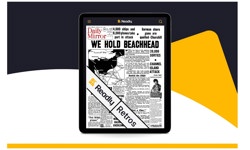
Newspapers & Magazines (N&M) are not operating in a vacuum. Other supply chains have been generating and using increasing amounts of data over the last few years. Traditionally, that data was usually created at the ‘hand-on’ point, where a physical product moved from one process to another or from one operator to another (eg. from a factory to a storage warehouse). Now these simple ‘hand-ons’ have been reduced, altered, deconstructed (with the increasing use of sub-contractors) or have parallel digital and online processes. The old ‘supply chain’ has fragmented into something much more complex – a series of overlapping networks. And the glue that holds all the bits together is data.
Now, so much data is being generated from multiple sources, especially from consumers themselves, that legacy data management processes are unable to cope. Artificial intelligence (AI) is a tool to automate matters, allowing computers to collect, analyse and use that data in real-time, in new ways and with less human intervention. In the process, data can streamline processes, change relationships, reduce costs and increase efficiency. There are two major areas… (1) predictive analytics (forecasting the future) and (2) inventory and supply chain management (dynamically adapting to the present).
AI has the potential to impact on any supply chain: driving topline sales growth, reducing cost and increasing efficiency and profitability.
Evolving, fragmenting, reconnecting
Behind all the current market mayhem, there is a clear evolutionary progression taking place in media, although the pace of change is becoming bewilderingly fast. It is the changes at publisher level which are rippling down and reshaping the supply processes below…
Stage 1: Print Only
- Publisher. This stable, legacy state is just a dim (but profitable) memory for most media companies.
- Supply chain. This stage was served by a single dominant supply chain: a series of structured ‘hand-ons’ in a process with clearly defined roles focused on retail newsstand sales. The core chain is publisher to printer to warehouse to retailer. Data is becoming increasingly important in refining copy allocations, waste management and retail space and range decisions, as well as directing growing subscription activity.
Stage 2: Print-first
- Publisher. Digital is coming on-stream, but usually as a bolt-on. This is a period of change. The publisher is easing into a more digital future, but is still locked into legacy models, culture and processes. A number of companies are still at this stage and may well currently have good, profitable businesses – but for how long?
- Supply chain. This stage is served by multiple supply chains. Four key content pipelines are emerging, for both print and digital, and with an increasing element of publisher direct-to-consumer (D2C) activity – see panel.
Stage 3: Digital-first
- Publisher. This is when change flips into disruption. It is a major pivot point, which usually drives a complete restructure. This requires major changes to organisations, mindsets and people. And often the need to take a profit hit, as the investment to do this properly is significant. Multiple revenue streams and products increase in the rush to diversify. The ‘publisher’ is evolving into a ‘media company’. In addition, the consumer is becoming more demanding and wanting more of a two-way conversation with the content creators, rather than be reactive receivers of ‘published content’.
- Supply chain. The chains overlap and become more unstable. Yet each one is creating more isolated pools of deep data that need to be joined together to provide truly insightful and actionable insights. Publisher ‘push’ is morphing into consumer ‘pull’. The supply chain is becoming a demand chain.
Stage 4: Digital-only
- Media company. For existing companies, this is a complete rebuild and reboot. For start-ups this is ground zero. Digital-only is already a current reality for many B2B companies; it is a priority for news; but only a longer-term possibility for many consumer magazines, where print will remain a significant, but niche platform. The content platforms increasingly overlap and borrow from each other elements of what each one does, to create new hybrids. Also, what ‘digital’ actually means is very different for newspapers and magazines as the two media segments continue to diverge. Start-ups and migrating legacy companies compete, but often with very different business models and cost bases.
- Supply networks. The old, volume-driven supply chains have fragmented into networks. Data is the glue that holds together a complex range of relationships between media companies and consumers. The physical supply of products is becoming a subcontracted commodity service. The legacy ‘push’ supply chains have fallen apart or receded into the background, operating at a much smaller scale.
Key issues and trends behind the evolution
Behind this topline evolution, a number of other things are happening at the same time:
- Retail-first is flipping into subscription-first for many publishers. Subscription is morphing into membership.
- Data is the only constant, but there is simply too much of it from multiple sources and in different formats. The challenge of consolidating, cleaning and analysing data becomes a task (and an opportunity) in its own right – for both new players and legacy supply chain operations applying their skills and understanding in new ways.
- The accelerating pace of change opens up new challenges, but also stress-tests organisations – how robust, flexible and agile are they? Are the tech platforms in place? Are the required staff skills on stream? Changing the organisation is even more challenging than changing the revenue model.
- Merger and acquisition (M&A) activity can change the dynamics of a market overnight.
- The ‘complex consumer’ (a section in the report) wants everything. Should we give it to them? Can we afford to give it to them?
- Whoever controls and uses the data controls the supply chain. Where is the data consolidated? And analysed? And where is value added? In all this, there is real danger of data overload: there is simply too much of it from too many sources. There is a need to distinguish between ‘need to know’ and ‘nice to know’. And an understanding of the real RoI of truly actionable data… knowing which datasets combine to release added value and insight (joining up the data dots)… moving from ‘what’ to ‘why’… having the resources (tech tools and humans) to convert data into insight.
Through all this, the power and politics of data are becoming apparent. Whoever controls and uses the data controls the supply pipelines and networks. And ultimately owns the end consumer.
What does it all mean?
The DistriPress report highlights just how quickly and how radically our traditional supply chains and their processes are changing. Those companies who do not follow these changes will simply be left behind.
The legacy supply chain was a monolithic and relatively stable series of clearly defined ‘hand-ons’ between the publisher content creator through to the end consumer with mediators (eg. distributors, wholesalers, digital newsstands, etc) in between. In addition, a growing range of Support services are now feeding into the networks to support add-on products and services: live events, marketplaces and ecommerce. All this offers new opportunities for existing supply chain operators: especially the outbound delivery of linked goods and the reverse logistics for goods returns.
The trend in every supply chain is ‘disintermediation’, cutting out the intermediate steps in the drive to a 121, D2C relationship with the end-user. Yet, however appealing and strategically correct that may be, the reality of the ‘complex consumer’ is that mediators still need to exist – albeit in a reduced and redefined role – to offer a rounded service to the end reader.
The smarter usage of data opens up all kinds of possibilities to run existing operations more efficiently and profitably. Yet it also provides an opportunity to get involved in new ways of delivering content to consumers, who themselves are changing rapidly.
There are many encouraging examples, digital editions being one of them, of DistriPress members leveraging their assets – contacts, skills, a deep understanding of how magazines work and practical delivery and supply management capabilities.
Yet the enabler of these new opportunities is tech – both the systems themselves and the staff skills to use them. This requires a long-term financial investment as well as a willingness to change and adapt at speed.
As the DistriPress Member Survey demonstrates, there are many companies who are looking with optimism and confidence to a much more data-led future.
The Four Key Supply Chains
- D2C print. This is founded on the postal delivery of print issues with the subscription being the core payment mechanism. However, payment methods are changing as is the increasing interest in single-copy home delivery. In addition, the growth of publisher ecommerce usually requires the home delivery of physical products, either as one-off purchases or as part of an ongoing subscription. This opens up other D2C fulfilment options (eg. Amazon, grocery home delivery, etc).
- Mediated print. Historically, this has been through the established newsstand supply chain, based on single copy sales, although retail subscriptions (committed orders fulfilled through a retail outlet) have become an important channel, especially for newspapers. The established fulfilment chain is publisher to distributor / wholesaler to retail outlet for an in-store consumer sale.
- D2C digital. Here, the range of published content products is growing fastest, with the publisher’s own branded website being the core access point for consumers. Other digital products include enewsletters, video channels, audio (both streamed channels and downloadable podcasts), digital editions, webinars and virtual events, archived content, whitepapers and downloadable resources. Non-digital products (principally live events and ecommerce goods) are usually managed through the publisher’s own website.
- Mediated digital. The mediators of digital content range across social media platforms (eg. Facebook, Instagram, etc), news aggregators (eg. Apple News, Google News, etc) and digital newsstands (eg. Readly, PressReader, Magzter, etc), although the clear distinctions as to what each mediator does is becoming more blurred and increasingly dominated by the major FAANG tech giants.
For full details of all DistriPress reports, events and activities, contact Lizanne Barber, DistriPress managing director. A second report, ‘The Global Market for Newspapers & Magazines’ was published in October.
This article was first published in InPublishing magazine. If you would like to be added to the free mailing list to receive the magazine, please register here.












